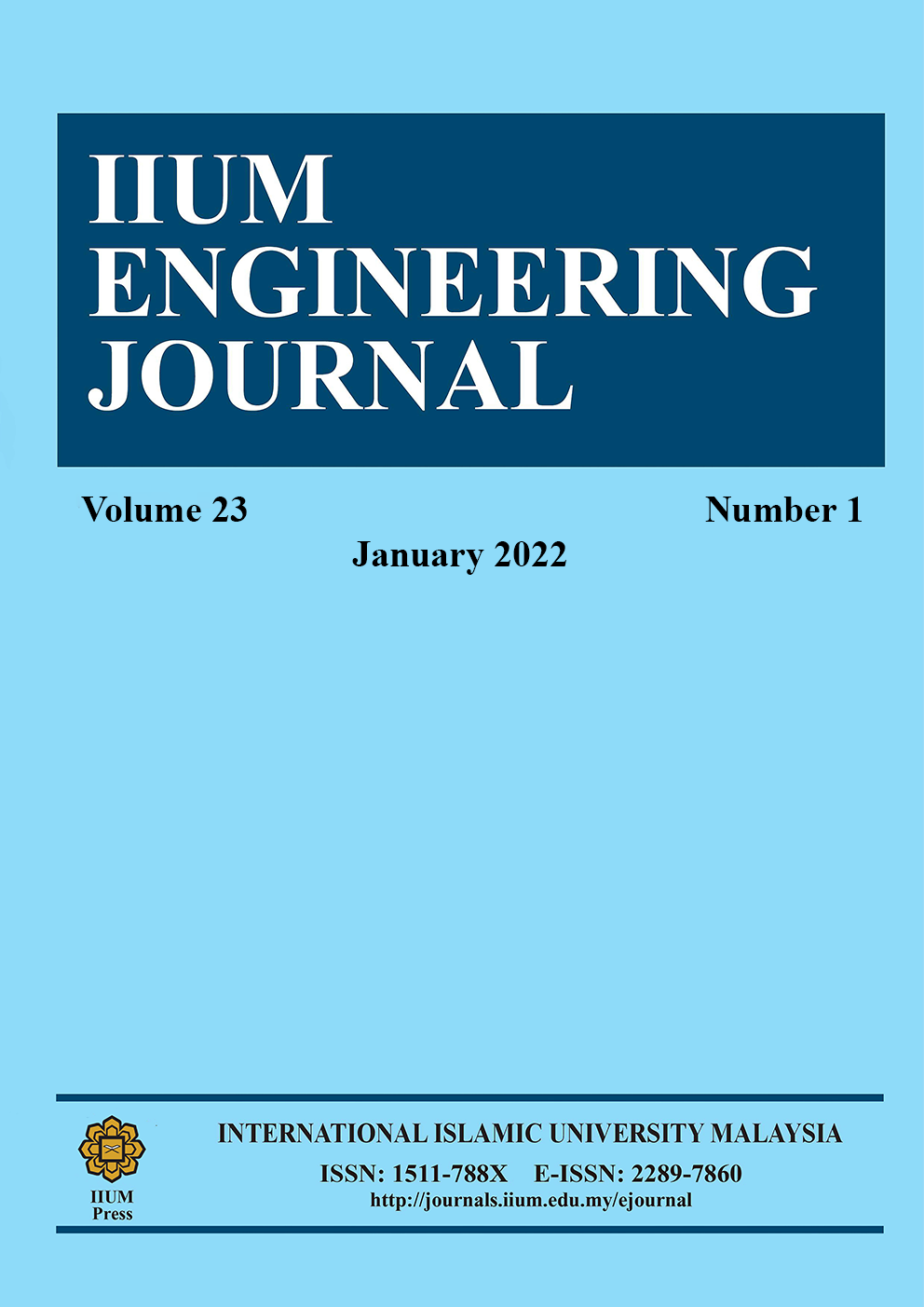POTENTIAL VOLUMIZING EFFECT OF THE POST-MORPH LIME FILLER IN ATTENUATING CONCRETE CARBONATION
DOI:
https://doi.org/10.31436/iiumej.v23i1.1788Keywords:
Mussel shell ash, natural carbonation, calcium carbonate crystalAbstract
A study on the crystallography of the lime that comes from mussel shell has been conducted to determine the packing density of the material. The experimental analysis encompasses of concrete samples preparation with lime replacement at 5%, 7.5% and 10% by cement weight. The samples were carbonised naturally over a period of six months and subjected to the phenolphthalein test at 60, 90, 120 and 180 days. It has been found that lime originating from the mussel shell is of both the aragonitic and calcitic crystal types. Both crystal polymorphs of aragonite and calcite are denser than the typical normal concrete by 27.8% and 18.3% respectively. This suggest a volumizing effect that is beneficial to reduce carbonation penetration into the capillarity of the concrete. Results from the carbonation test indicate that concrete containing mussel shell lime ash showed up to 51% lower carbonation coefficient and significantly lower intensity of capillarity as shown via FESEM.
ABSTRAK: Kajian mengenai kristalografi kapur yang didapati daripada kulit kupang telah dijalankan bagi menentukan kepadatan bahan tersebut. Analisis eksperimen merangkumi penyediaan sampel-sampel konkrit yang mengandungi gantian kapur pada 5%, 7.5% dan 10% daripada berat simen. Sampel-sampel telah dikarbonatkan secara alami selama enam bulan dan menjalani ujian fenolftalin pada usia 60, 90, 120 dan 180 hari. Kajian telah mendapati bahawa kulit kupang terdiri daripada kapur-kapur berjenis aragonit dan kalsit. Kedua-dua polimorf kapur aragonit dan kalsit adalah 27.8% dan 18.3% lebih tumpat berbanding konkrit biasa. Hal ini berpotensi menjadi bahan penumpat yang bagus untuk mengurangkan serapan pengkarbonatan ke dalam kapilari konkrit. Keputusan ujian pengkarbonatan menunjukkan konkrit yang mengandungi abu kapur kulit kupang mempunyai pekali pengkarbonatan sehingga 51% lebih rendah dan mempunyai kerendahan kapilariti yang signifikan seperti yang ditunjukkan melalui FESEM.
Downloads
Metrics
References
Sideris KK, Anagnostopoulos NS. (2013) Durability of normal strength self-compacting concretes and their impact on service life of reinforced concrete structures. Construction and Building Materials, 41: 491–497. https://doi.org/10.1016/j.conbuildmat.2012.12.042 DOI: https://doi.org/10.1016/j.conbuildmat.2012.12.042
Phung QT, Maes N, Jacques D, Bruneel E, Van Driessche I, Ye G, De Schutter G. (2015) Effect of limestone fillers on microstructure and permeability due to carbonation of cement pastes under controlled CO2 pressure conditions. Construction and Building Materials, 82: 376–390. https://doi.org/10.1016/j.conbuildmat.2015.02.093
Rezvani M, Proske T. (2017) Influence of chemical-mineralogical properties of limestone on the shrinkage behaviour of cement paste and concrete made of limestone-rich cements. Construction and Building Materials, 157: 818–828. https://doi.org/10.1016/j.conbuildmat.2017.09.101
Ekolu SO. (2016) A review on effects of curing, sheltering, and CO2 concentration upon natural carbonation of concrete. Construction and Building Materials, 127: 306–320. https://doi.org/10.1016/j.conbuildmat.2016.09.056 DOI: https://doi.org/10.1016/j.conbuildmat.2016.09.056
Shibata T. (2002) Cost of corrosion in Japan. Corrosion Science & Technology, 31(2): 97-102.
Benítez P, Rodrigues F, Talukdar S, Gavilán S, Varum H, Spacone E. (2019) Analysis of correlation between real degradation data and a carbonation model for concrete structures. Cement and Concrete Composites, 95: 247–259. https://doi.org/10.1016/j.cemconcomp.2018.09.019 DOI: https://doi.org/10.1016/j.cemconcomp.2018.09.019
Nakai A, Imamoto K, Kiyohara C, Sato S, Tanaka A, Niwano K, Amemiya S. (2013) Influence of Finishing Materials on Carbonation Suprression of Concrete in Existing Structure. RILEM International Workshop on Performance-Based Specification and Control of Conrete Durability, 377-384.
Lollini F, Redaelli E, Bertolini L. (2016) A study on the applicability of the efficiency factor of supplementary cementitious materials to durability properties. Construction and Building Materials, 120: 284–292. https://doi.org/10.1016/j.conbuildmat.2016.05.031 DOI: https://doi.org/10.1016/j.conbuildmat.2016.05.031
Bogas JA, Real S, Ferrer B. (2016) Biphasic carbonation behaviour of structural lightweight aggregate concrete produced with different types of binder. Cement and Concrete Composites, 71: 110–121. https://doi.org/10.1016/j.cemconcomp.2016.05.006 DOI: https://doi.org/10.1016/j.cemconcomp.2016.05.006
Mohammed MK, Dawson AR, Thom NH. (2014) Carbonation of filler typed self-compacting concrete and its impact on the microstructure by utilization of 100% CO2 accelerating techniques. Construction and Building Materials, 50: 508–516. https://doi.org/10.1016/j.conbuildmat.2013.09.052 DOI: https://doi.org/10.1016/j.conbuildmat.2013.09.052
Singh N, Singh SP. (2016) Carbonation resistance and microstructural analysis of Low and High Volume Fly Ash Self Compacting Concrete containing Recycled Concrete Aggregates. Construction and Building Materials, 127: 828–842. https://doi.org/10.1016/j.conbuildmat.2016.10.067 DOI: https://doi.org/10.1016/j.conbuildmat.2016.10.067
Shah V, Bishnoi S. (2018) Carbonation resistance of cements containing supplementary cementitious materials and its relation to various parameters of concrete. Construction and Building Materials, 178: 219–232. https://doi.org/10.1016/j.conbuildmat.2018.05.162 DOI: https://doi.org/10.1016/j.conbuildmat.2018.05.162
Li Z, Li S. (2018) Carbonation resistance of fly ash and blast furnace slag based geopolymer concrete. Construction and Building Materials, 163: 668–680. https://doi.org/10.1016/j.conbuildmat.2017.12.127 DOI: https://doi.org/10.1016/j.conbuildmat.2017.12.127
Marques PF, Chastre C, Nunes Â. (2013) Carbonation service life modelling of RC structures for concrete with Portland and blended cements. Cement and Concrete Composites, 37(1): 171–184. https://doi.org/10.1016/j.cemconcomp.2012.10.007 DOI: https://doi.org/10.1016/j.cemconcomp.2012.10.007
Tekin I, Yasin Durgun M, Gencel O, Bilir T, Brostow W, Hagg Lobland HE. (2017) Concretes with synthetic aggregates for sustainability. Construction and Building Materials, 133: 425–432. https://doi.org/10.1016/j.conbuildmat.2016.12.110 DOI: https://doi.org/10.1016/j.conbuildmat.2016.12.110
Proske T, Hainer S, Rezvani M, Graubner CA. (2014) Eco-friendly concretes with reduced water and cement content - Mix design principles and application in practice. Construction and Building Materials, 67(part C): 413–421. https://doi.org/10.1016/j.conbuildmat.2013.12.066 DOI: https://doi.org/10.1016/j.conbuildmat.2013.12.066
Harilal M, Rathish VR, Anandkumar B, George RP, Mohammed MSHS, Philip J, Amarendra G. (2019) High performance green concrete (HPGC) with improved strength and chloride ion penetration resistance by synergistic action of fly ash, nanoparticles and corrosion inhibitor. Construction and Building Materials, 198: 299–312. https://doi.org/10.1016/j.conbuildmat.2018.11.266 DOI: https://doi.org/10.1016/j.conbuildmat.2018.11.266
Cui D, Banthia N, Wang Q, Sun W. (2019) Investigation on porosity of partly carbonated paste specimens blended with fly ash through dual CT scans. Construction and Building Materials, 196, 692–702. https://doi.org/10.1016/j.conbuildmat.2018.11.156 DOI: https://doi.org/10.1016/j.conbuildmat.2018.11.156
Esquinas AR, Ledesma EF, Otero R, Jiménez JR, Fernández JM. (2018) Mechanical behaviour of self-compacting concrete made with non-conforming fly ash from coal-fired power plants. Construction and Building Materials, 182: 385–398. https://doi.org/10.1016/j.conbuildmat.2018.06.094 DOI: https://doi.org/10.1016/j.conbuildmat.2018.06.094
Bucher R, Diederich P, Escadeillas G, Cyr M. (2017) Service life of metakaolin-based concrete exposed to carbonation: Comparison with blended cement containing fly ash, blast furnace slag and limestone filler. Cement and Concrete Research, 99: 18–29. https://doi.org/10.1016/j.cemconres.2017.04.013 DOI: https://doi.org/10.1016/j.cemconres.2017.04.013
Carevi? V, Ignjatovi? I, Dragaš J. (2019) Model for practical carbonation depth prediction for high volume fly ash concrete and recycled aggregate concrete. Construction and Building Materials, 213: 194–208. https://doi.org/10.1016/j.conbuildmat.2019.03.267 DOI: https://doi.org/10.1016/j.conbuildmat.2019.03.267
Younsi A, Turcry P, Aït-Mokhtar A, Staquet S. (2013) Accelerated carbonation of concrete with high content of mineral additions: Effect of interactions between hydration and drying. Cement and Concrete Research, 43(1): 25–33. https://doi.org/10.1016/j.cemconres.2012.10.008 DOI: https://doi.org/10.1016/j.cemconres.2012.10.008
Yagüe A, Valls S, Vázquez E, Albareda F. (2005) Durability of concrete with addition of dry sludge from waste water treatment plants. Cement and Concrete Research, 35(6): 1064–1073. https://doi.org/10.1016/j.cemconres.2004.07.043 DOI: https://doi.org/10.1016/j.cemconres.2004.07.043
Sideris KK, Tassos C, Chatzopoulos A, Manita P. (2018) Mechanical characteristics and durability of self compacting concretes produced with ladle furnace slag. Construction and Building Materials, 170: 660–667. https://doi.org/10.1016/j.conbuildmat.2018.03.091 DOI: https://doi.org/10.1016/j.conbuildmat.2018.03.091
Palm S, Proske T, Rezvani M, Hainer S, Müller C, Graubner CA. (2016) Cements with a high limestone content - Mechanical properties, durability and ecological characteristics of the concrete. Construction and Building Materials, 119: 308–318. https://doi.org/10.1016/j.conbuildmat.2016.05.009
El-Hassan H, Shao Y. (2015) Early carbonation curing of concrete masonry units with Portland limestone cement. Cement and Concrete Composites, 62: 168–177. https://doi.org/10.1016/j.cemconcomp.2015.07.004 DOI: https://doi.org/10.1016/j.cemconcomp.2015.07.004
Hussin MH, Othman NH, Wan Ibrahim MH. (2019) Carbonation of concrete containing mussel (Perna viridis) shell ash. Journal of Engineering, Design and Technology, 17(5): 904–928. https://doi.org/10.1108/JEDT-12-2018-0228 DOI: https://doi.org/10.1108/JEDT-12-2018-0228
Phung QT, Maes N, Jacques D, Bruneel E, Van Driessche I, Ye G, De Schutter G. (2015) Effect of limestone fillers on microstructure and permeability due to carbonation of cement pastes under controlled CO2 pressure conditions. Construction and Building Materials, 82: 376–390. https://doi.org/10.1016/j.conbuildmat.2015.02.093 DOI: https://doi.org/10.1016/j.conbuildmat.2015.02.093
Lollini F, Redaelli E, Bertolini L. (2014) Effects of portland cement replacement with limestone on the properties of hardened concrete. Cement and Concrete Composites, 46: 32–40. https://doi.org/10.1016/j.cemconcomp.2013.10.016 DOI: https://doi.org/10.1016/j.cemconcomp.2013.10.016
Río O, Nguyen VD, Nguyen K. (2015) Exploring the potential of the functionally graded SCCC for developing sustainable concrete solutions. Journal of Advanced Concrete Technology, 13(3): 193–204. https://doi.org/10.3151/jact.13.193 DOI: https://doi.org/10.3151/jact.13.193
Rezvani M, Proske T. (2017) Influence of chemical-mineralogical properties of limestone on the shrinkage behaviour of cement paste and concrete made of limestone-rich cements. Construction and Building Materials, 157: 818–828. https://doi.org/10.1016/j.conbuildmat.2017.09.101 DOI: https://doi.org/10.1016/j.conbuildmat.2017.09.101
Courard L, Michel F. (2014). Limestone fillers cement based composites: Effects of blast furnace slags on fresh and hardened properties. Construction and Building Materials, 51: 439–445. https://doi.org/10.1016/j.conbuildmat.2013.10.076 DOI: https://doi.org/10.1016/j.conbuildmat.2013.10.076
Valcuende, M., & Parra, C. (2010). Natural carbonation of self-compacting concretes. Construction and Building Materials, 24(5), 848–853. https://doi.org/10.1016/j.conbuildmat.2009.10.021 DOI: https://doi.org/10.1016/j.conbuildmat.2009.10.021
Meddah MS, Lmbachiya MC, Dhir RK. (2014) Potential use of binary and composite limestone cements in concrete production. Construction and Building Materials, 58: 193–205. https://doi.org/10.1016/j.conbuildmat.2013.12.012 DOI: https://doi.org/10.1016/j.conbuildmat.2013.12.012
Tsivilis S, Batis G, Chaniotakis E, Grigoriadis G, Theodossis D. (2000) Properties and behavior of limestone cement concrete and mortar. Cement and Concrete Research, 30(10): 1679–1683. https://doi.org/10.1016/S0008-8846(00)00372-0 DOI: https://doi.org/10.1016/S0008-8846(00)00372-0
Dhouibi L, Triki E, Raharinaivo A. (2002) The application of electrochemical impedance spectroscopy to determine the long-term effectiveness of corrosion inhibitors for steel in concrete. Cement and Concrete Composites, 24(1): 35–43. https://doi.org/10.1016/S0958-9465(01)00062-2 DOI: https://doi.org/10.1016/S0958-9465(01)00062-2
Dariva CG, Galio AF. (2014) Corrosion inhibitors–principles, mechanisms and applications. Developments in corrosion protection, 16: 365-378. http://dx.doi.org/10.5772/57255 DOI: https://doi.org/10.5772/57255
Possan E, Thomaz WA, Aleandri GA, Felix EF, dos Santos ACP. (2017) CO2 uptake potential due to concrete carbonation: A case study. Case Studies in Construction Materials, 6: 147–161. DOI: https://doi.org/10.1016/j.cscm.2017.01.007
Oliveira TV, Nogueira AA. (2016) Analysis of development of carbonation and surface wear of the concrete: a case study in Ship Lock 1 of the transposition system of Tucuruí dam. Journal of Building Pathology and Rehabilitation, 1(1): 1–8. https://doi.org/10.1007/s41024-016-0019-0 DOI: https://doi.org/10.1007/s41024-016-0019-0
Ministry of Energy, Green Technology and Water (2017), Green Technology Masterplan Malaysia 2017-2030. Malaysia. https://doi.org/ISBN NO. 978-967-5893-09-4
Hussin MH. (2018) Keupayaan kadar pengkarbonatan konkrit campuran abu kulit kupang sebagai bahan gantian separa simen. Master thesis, Universiti Tun Hussein Onn Malaysia, Department of Civil Engineering.
Teychenné DC, Franklin RE, Erntroy HC. (1997).Design of normal concrete mixes. Building Research Establishment Ltd, 331(1): 46.
Shalon R, Reinitz RC. (1958) Mixing time of concrete: technological and economic aspects. Building Research Station.
Jenkins R, Snyder RL. (1996) Introduction to X-ray Powder Diffractometry. In Introduction to X-ray Powder Diffractometry. John Wiley. https://doi.org/10.1002/9781118520994. DOI: https://doi.org/10.1002/9781118520994
British Standards Institution. Determination of Carbonation Depth in Hardened Concrete by the Phenolphthalein Method. London, BS EN 14630. 2006
British Standards Institution. Determination of Resistance to Carbonation. London, BS EN 13295. 2004
British Standards Institution. Determination of the Carbonation Resistance at Atmospheric Levels of Carbon Dioxide. London, BS EN 12390 – 10. 2017
Mehta PK, Monteiro PJM. (2006) Third Edition Prentice- Hall, Inc., Englewood Cliffs, NJ. In Concrete: microstructure, properties, and materials.
Khankhaje E, Hussin MW, Mirza J, Rafieizonooz M, Salim MR, Siong HC, Warid MNM. (2016) On blended cement and geopolymer concretes containing palm oil fuel ash. Materials and Design, 89: 385–398. https://doi.org/10.1016/j.matdes.2015.09.140 DOI: https://doi.org/10.1016/j.matdes.2015.09.140
Santhakumar AR. (2007) Concrete technology. Oxford University Press.
Boggs S. (2009) Petrology of sedimentary rocks, second edition. In Petrology of Sedimentary Rocks, Second Edition (2nd ed., Vol. 9780521897167). Cambridge University Press. https://doi.org/10.1017/CBO9780511626487. DOI: https://doi.org/10.1017/CBO9780511626487
Waseda Y, Muramatsu A. (2004) Morphology control of materials and nanoparticles: advanced materials processing and characterization. Berlin. Springer-Verlag. DOI: https://doi.org/10.1007/978-3-662-08863-0
Klein and Dutrov (2008). The 23rd Edition of the Manual of Mineral Science (23rd ed.). Hoboken, NJ. Wiley J.
Wahab MA. (2009) Essentials of Crystallography. Oxford. Alpha Science International.
Antao SM, Hassan I. (2010) Temperature dependence of the structural parameters in the transformation of aragonite to calcite, as determined from in situ synchrotron powder X-ray-diffraction data. Canadian Mineralogist, 48(5): 1225–1236. https://doi.org/10.3749/canmin.48.5.1225 DOI: https://doi.org/10.3749/canmin.48.5.1225
Graf DL. (1961) Crystallographic tables for the rhombohedral carbonates. American Mineralogist, 46: 1283–1316.
Haldar SK. (2020) Introduction to Mineralogy and Petrology (2nd ed.). Elsevier. https://doi.org/10.1016/C2012-0-03337-6 DOI: https://doi.org/10.1016/B978-0-12-820585-3.00004-1
Moore CH. (2001) Developments in Sedimentology. Elsevier.
Buasri A, Chaiyut N, Loryuenyong V, Worawanitchaphong P, Trongyong S. (2013) Calcium oxide derived from waste shells of mussel, cockle, and scallop as the heterogeneous catalyst for biodiesel production. The Scientific World Journal, 2013. https://doi.org/10.1155/2013/460923 DOI: https://doi.org/10.1155/2013/460923
Hossain A, Bhattacharyya SR, Aditya G. (2015) Biosorption of cadmium by waste shell dust of fresh water mussel lamellidens marginalis: Implications for metal bioremediation. ACS Sustainable Chemistry and Engineering. https://doi.org/10.1021/sc500635e DOI: https://doi.org/10.1021/sc500635e
Monneron-Gyurits M, Joussein E, Soubrand M, Fondanèche P, Rossignol S. (2018) Valorization of mussel and oyster shells toward metakaolin-based alkaline activated material. Applied Clay Science, 162: 15–26. https://doi.org/10.1016/j.clay.2018.05.027 DOI: https://doi.org/10.1016/j.clay.2018.05.027
Rochelle CA, Czernichowski-Lauriol I, Milodowski AE. (2004) The impact of chemical reactions on CO2 storage in geological formations: A brief review. Geological Society, London, Special Publications, 233(1): 87-106. DOI: https://doi.org/10.1144/GSL.SP.2004.233.01.07
Hamester MRR, Balzer PS, Becker D. (2012) Characterization of calcium carbonate obtained from oyster and mussel shells and incorporation in polypropylene. Materials Research, 15(2): 204–208. https://doi.org/10.1590/S1516-14392012005000014 DOI: https://doi.org/10.1590/S1516-14392012005000014
Hossain MZ. (2013) Waste Shell Husks Concrete: Durability, Permeability and Mechanical Properties. Journal of Building Construction and Planning Research, 01(03): 61–66. https://doi.org/10.4236/jbcpr.2013.13009 DOI: https://doi.org/10.4236/jbcpr.2013.13009
Neville AM. (2011) Properties of concrete (5th ed.). England. Longman.
Palm S, Proske T, Rezvani M, Hainer S, Müller C, Graubner CA. (2016) Cements with a high limestone content - Mechanical properties, durability and ecological characteristics of the concrete. Construction and Building Materials, 119: 308–318. https://doi.org/10.1016/j.conbuildmat.2016.05.009 DOI: https://doi.org/10.1016/j.conbuildmat.2016.05.009
Chang JJ, Yeih W, Huang R, Chi JM. (2003) Mechanical properties of carbonated concrete. Journal of the Chinese Institute of Engineers, Transactions of the Chinese Institute of Engineers,Series A/Chung-Kuo Kung Ch’eng Hsuch K’an, 26(4): 513–522. https://doi.org/10.1080/02533839.2003.9670804 DOI: https://doi.org/10.1080/02533839.2003.9670804
Downloads
Published
How to Cite
Issue
Section
License
Copyright (c) 2021 IIUM Press

This work is licensed under a Creative Commons Attribution-NonCommercial 4.0 International License.






















